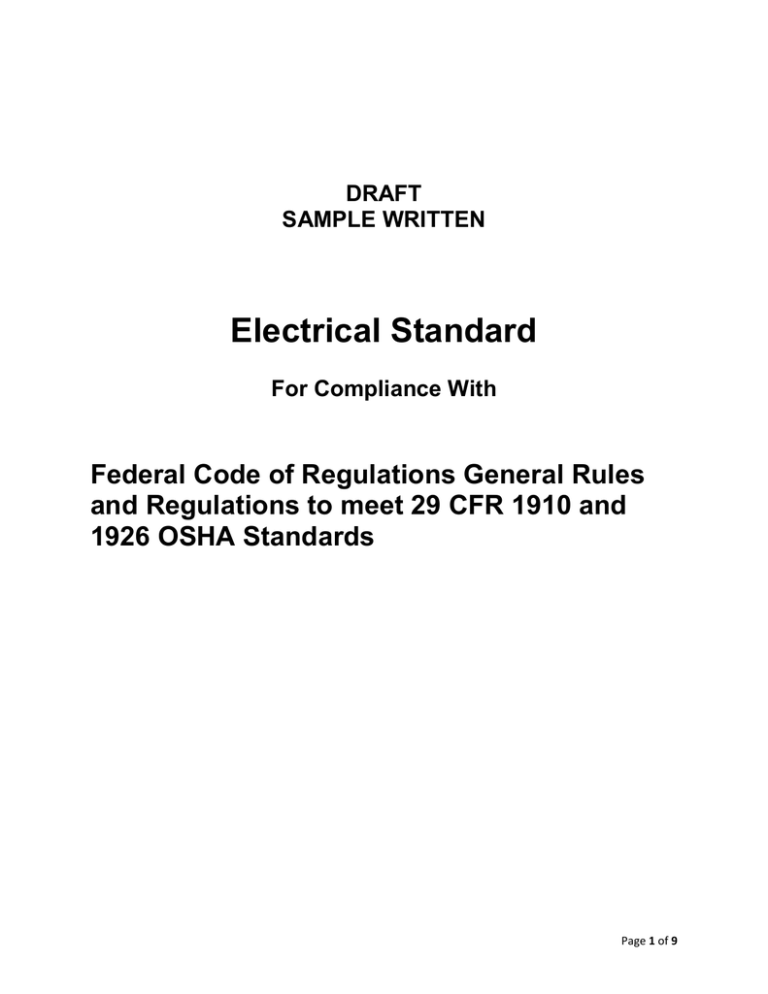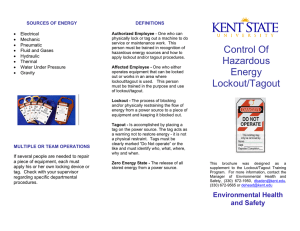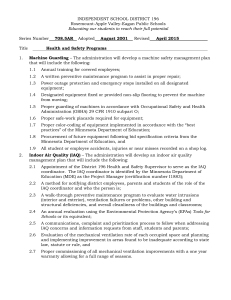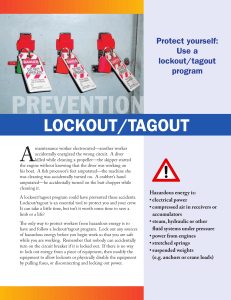Electrical Safety Standard
advertisement

DRAFT SAMPLE WRITTEN Electrical Standard For Compliance With Federal Code of Regulations General Rules and Regulations to meet 29 CFR 1910 and 1926 OSHA Standards Page 1 of 9 ACKNOWLEDGMENTS This material was compiled by the staff of the South Dakota OSHA On-Site Consultation Program. NOTE: this sample plan is provided only as a guide to assist in complying with Federal OSHA's General Rules and Regulations. It is not intended to supersede the requirements detailed in the guidelines. Employers should review the standard for particular requirements which are applicable to their specific situation. Employers will need to add information relevant to their particular facility and industry, and types of machine(s) and/or system(s), in order to develop an effective program. Employers should note that certain programs are expected to be reviewed at least on an annual basis and updated when necessary. This material and Safety and Health Consultation Services are provided free of charge to owners, proprietors, and managers of small businesses, by the South Dakota On-Site Consultation Program, Engineering Extension, South Dakota State University, a program funded largely by the Occupational Safety and Health Administration (OSHA), an agency of the U.S. Department of Labor. The information contained in this document is not considered a substitute for any provision of the standard. UPDATED: February 2014 Page 2 of 9 I. What the OSHA Standard Covers 29 CFR 1910.147 (c)(7) Training and Communication A. The employer will ensure that the purpose and function of the energy control program are understood by employees and that the knowledge and skills required for the safe application, usage, and removal of energy controls are required by employees. The training shall include the following: 1. Each authorized employee shall receive training in the recognition of applicable hazardous energy sources, the type and magnitude of the energy available in the workplace, and the methods and means necessary for energy control procedures. 2. Each affected employee shall be instructed in the purpose and use of the energy control procedures. 3. All other employees whose work operations are or may be in an area where energy control procedures may be utilized, shall be instructed about the procedure, and about the prohibition relating to attempts to restart or reenergize machines to equipment which are locked out or tagged out. B. When tagout systems are used, employees shall also be trained in the following limitations of tags: 1. Tags are essentially warning devices affixed to energy isolating devices, and do not provide the physical restraint those devices that are provided by a lock. 2. When a tag is attached to an energy isolating means, it is nor to be removed without authorization of the authorized person responsible for it, and it is never to be bypassed, ignored, or otherwise defeated. 3. Tags must be legible and understandable by all authorized employees, affected employees, and all other employees whose work operations are or may be in the area, in order to be effective. 4. Tags and their means of attachment must be made of materials, which will withstand the environmental conditions encountered in the workplace. 5. Tags may evoke a false sense of security, and their meaning needs to be understood as part of the overall energy detached during the use. Page 3 of 9 C. Employee Training 1. Retraining shall be provided for all authorized and affected employees whenever there is a change in their job assignments, a change in machines, equipment or processes that present a new hazard, or when there is a change in the energy control procedures. 2. Additional retraining shall also be conducted whenever a periodic inspection under paragraph (c)(6) of this section reveals, or whenever the employer has reason to believe, that there are deviations from or inadequacies in the employee’s knowledge or use of the energy control procedures. 3. The retraining shall reestablish employee proficiency and introduce new or revised control methods and procedures, as necessary. D. The employer shall certify that employee training has been accomplished and is being kept up to date. The certification shall contain each employee’s name and dates of training. II. Brief Overview of Required Training OSHA requires that all authorized employees be trained in: a. There are changes in equipment, job assignment, or procedures. b. Hazardous energy sources in use at this facility. c. How to perform the lockout/tagout procedure. OSHA requires that all affected employees must be trained in the purpose and use of lockout/tagout. OSHA requires that all other employees must be instructed on the purpose of the plan, but not in the actual use. OSHA requires that retraining be done when: a. There are changes in equipment, job assignment, or procedures. b. An audit shows deficiencies with procedures. c. The employer feels the procedures should be reviewed. III. Briefly What the Standard Covers Control of Hazardous Energy (Lockout/Tagout) 29 CFR 1910.147 covers servicing and maintenance of equipment where unexpected energization or startup of the equipment could harm employees. Page 4 of 9 How will this apply in your facility to include? Repair/replacement work Renovation work Modifications or other adjustments to power equipment Now list the areas where lockout/tagout is required at this facility. ________________________________________ ________________________________________ In general, the OSHA standard requires that all power sources that can be locked out, must be locked for servicing or maintenance. Just a reminder, that the use of guards or interlock devices cannot be used as a substitute for locks during major servicing. Now take a few moments to look at what areas of the workplace need to have lockouts or tags used. Use the floor plans or drawings to show specific equipment and area. The standard requires that the employees: Develop a written energy control program that clearly explains all procedures for lockout/tagout. Provide training to those workers affected by these procedures. Identify and differentiate between authorized and affected employees. Establish specific procedures for larger systems or machines for lockout/tagout steps to be followed by the authorized person(s). Authorized Employees - those who physically lock or tag out equipment for servicing/maintenance. Note: These individuals are not necessarily the people who normally operate the equipment. List the employees or job descriptions that are authorized: ____________________________________ ____________________________________ Affected Employees: Are those whose job requires them to operate equipment subject to lockout/tagout. Those who work in areas where lockout/tagout is used. Page 5 of 9 List the individuals who are considered affected by employees: ____________________________________ ____________________________________ Example: In listing individuals, use the example of the plant owner or supervisor from another department who happens to be touring the plant with a client. IV. Review of Company Specific Items Now you may want to use a video or audio-visuals to show the key points and then discuss items that are handled in a specific manner at your facility. You may want to use certain parts of the written company policy to show employees specifics, such as specific procedures on larger equipment or systems. Discuss the specific types of energy that may be found in your facility: Electrical Mechanical Pneumatic Fluid and Gases Hydraulic Thermal Water under pressure Gravity It may work to have the participants list the energy sources that are found in your facility: __________________________________ __________________________________ __________________________________ Review and emphasize the kinds of problems associated with the accidental release of energy. The video or audio/visual may be used. Accidental start-ups Electric shock Disabling injuries and death You may want to remind the participants that these accidents are usually the result of someone taking a short cut when servicing a piece of machinery, or occur when a worker doesn’t understand the equipment or job to be done. Page 6 of 9 Have the participants think of areas in your facility where these types of accidents could happen, or have happened. __________________________________ __________________________________ __________________________________ OSHA believes that failure to control hazardous energy sources results in: 10% of serious industrial accidents 28,000 lost work days/year Loss of about 120 lives/year Note: It can be very difficult if you can obtain statistics from actual accidents/injuries that occurred as a result of accidental release of energy at your facility. V. The Lockout/Tagout Procedure A lockout/tagout program covers the following: How to perform a shutdown How to isolate equipment How to apply and remove lockout devices, and How to safely release stored energy to assure that a zero energy state exists Discuss and demonstrate: How to perform a shutdown and isolate equipment. a. Notify all affected employees that you’re about to start a lockout procedure. b. Locate all energy sources that power the piece of equipment you’ll be servicing. Always look for hidden energy sources. Note: Some machines have more than one source of power, so you must make sure you know the machine and all power sources involved. Discuss and show pieces of equipment in your facility that have more than one power source. Discuss and Demonstrate: Applying and Removing Lockout Devices. Page 7 of 9 Note: Every power source has its own procedure for lockout. This may be pulling a plug, opening a disconnect switch, removing a fuse, closing a valve, bleeding the line, or placing a block in the equipment. a. Shut down the machine by following the normal method for shutdown. b. Turn off the energy at the main power source. c. Turn the machine switch back on, confirm that the power source has been deactivated. d. Attempt to restart the machine to guarantee that the power is shut off, then return the switch to the off position. e. Using your own lock, lock out all energy sources involved. f. With your lock in place, test the disconnect to make sure it can’t be turned on. Make absolutely sure the power can’t be supplies unless you know about it. g. If several people are needed to work on a piece of equipment, each one must apply their own lock. This prevents any accidental star-ups while another employee may still be working on the machinery. In this case, you’ll use a multiple lockout device that can accommodate several locks at once. Discuss and show a sample of the multiple lockout procedure. h. When all energy sources are locked, inform others of the lockout situation. One way to do this is by applying a tag to the power source. Discuss and show tags used at your facility. Make a listing of all information required on the tag. Name Date Reason for the lockout/tagout or machine number Note: Never use another employee’s lock and never lend yours. This protects you and your fellow workers. Discuss and Demonstrate an example of Safe Release of Stored Energy. Equipment must be at a “zero energy state” before servicing or maintenance work can begin. a. Drain all valves, bleed off air from a system, eliminate stored hydraulic pressure, or use any method to release energy that is detailed in your company procedure. b. Test machine to assure that all energy was disconnected or released. c. After servicing is finished: 1. Remove all tools from the area. 2. Replace all machine guards. Page 8 of 9 d. Remove your tag, lock, chain, block, or valve control. present for the multiple lock method. e. Reconnect all sources of energy. f. Restart the equipment. VI. What may be Audits and Other Concerns of Lockout/Tagout The OSHA standard call for periodic inspections or audits on the existing lockout/tagout procedure, training, and implementation. All audits must be dome by an authorized employee who does nor use the energy control procedure being inspected. Audits must be done at least annually and should include: a. Do employees understand the purpose of lockout/tagout? b. Are proper locks and tags being used? c. Are established procedures being followed? Each audit must be documented. Show and discuss the company audit sheet. Other concerns: Working with outside contractors. Outside contractor must be informed of your lockout/tagout procedure. You must understand and comply with the contractor’s lockout/tagout procedures unless your program is stronger. Shift and personnel changes. In general, if a piece of equipment is locked out at shift change, the person on the next shift must apply has lock before the employee who is leaving can remove his/her lockout/tagout tool. Power source that cannot be locked out. In very rare cased, a power source cannot be physically locked out. Discuss this situation with your supervisor, to find out if tagout alone may safely be used. Use of quizzes or worksheets to help to strengthen the presentation. Page 9 of 9


